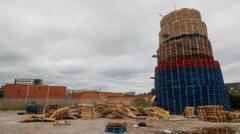What Caused Police to Declare a Major Incident at the Bonfire Site?

Understanding the Controversy Surrounding the Belfast Bonfire Incident
In recent days, a contentious bonfire in South Belfast has drawn significant attention, leading the police to declare a "major incident." This situation arises from the interplay of cultural practices, public safety concerns, and political tensions within Northern Ireland, all of which culminate in the upcoming Eleventh Night celebrations. With the bonfire set to be lit on July 11 as part of the festivities that commemorate the Twelfth of July, which marks the Protestant victory at the Battle of the Boyne in 1690, the stakes have never been higher. The decision to dismantle the bonfire has sparked a heated debate among community leaders, politicians, and residents, making this a pivotal moment in local governance and community relations.
The Background of Eleventh Night Celebrations
The Eleventh Night is an important cultural event in some unionist communities in Northern Ireland. It serves as a precursor to the Twelfth of July, a date that holds historical significance as it commemorates the Battle of the Boyne, where Protestant King William III defeated Catholic King James II. The bonfires traditionally lit on this night are not merely celebratory; they symbolize loyalty to the crown and the Protestant community’s heritage. However, they also raise concerns about safety, environmental hazards, and community tensions.
Historical Context of the Bonfire Tradition
The bonfire tradition has deep roots in Northern Ireland’s history, with its origins tied to the cultural and political landscape that defines the region. The lighting of bonfires on the Eleventh Night dates back centuries and is a way for communities to celebrate their identity. However, as society evolves, the implications of these celebrations are increasingly scrutinized.
The Current Situation: Major Incident Declared
As tensions rise over the contentious bonfire in South Belfast, the police have been thrust into a challenging position. The bonfire’s location near a critical electricity substation poses significant risks, particularly to the power supply of key hospitals, including the Royal Victoria Hospital and Belfast City Hospital. The potential for power outages raises alarms about public safety, especially concerning medical emergencies that could arise during the Eleventh Night festivities.
Concerns About Asbestos and Public Health
In addition to the risks associated with the bonfire’s proximity to essential infrastructure, there are serious health concerns related to the presence of asbestos at the bonfire site. Asbestos is a hazardous material that can pose severe health risks if disturbed. The Northern Ireland Environment Agency (NIEA) has been engaged in discussions with the landowner and the city council since May, working to find solutions for the safe removal of asbestos before the bonfire is lit.
The Role of Local Authorities
The Belfast City Council has taken a proactive stance by voting to send in contractors to dismantle the bonfire. This decision reflects a growing recognition of the need to prioritize public safety over cultural tradition in this instance. However, the council's actions have been met with resistance from various community groups and political leaders, illustrating the complex dynamics at play.
Political Reactions and Community Responses
Local politicians have voiced their opinions on the matter, with Sinn Féin MLA Pat Sheehan emphasizing the police's responsibility to ensure public safety. He criticized the lack of action from unionist leaders, calling for them to show leadership in dismantling the bonfire. Sheehan's comments highlight the intricate relationship between political leadership and community sentiments in Northern Ireland, where historical grievances often resurface during such events.
The Police's Dilemma: Balancing Safety and Community Sentiment
The Police Service of Northern Ireland (PSNI) finds itself in a precarious position. On one hand, they are tasked with maintaining public safety and preventing disorder, while on the other, they must navigate the cultural significance of the bonfire to the local community. The PSNI's decision-making process is further complicated by the potential for unrest if any operation to dismantle the bonfire is perceived as an affront to community traditions.
Potential for Escalation and Disorder
As the Eleventh Night approaches, the mood in the community has shifted. Reports of protests and blockades at the bonfire site indicate that tensions are running high, heightening fears of disorder. Activists, such as loyalist Jamie Bryson, have threatened legal action to prevent the bonfire from being dismantled, further complicating the police's operational decisions.
The Position of the Landowner
Boron Developments, the landowner of the bonfire site, has stated that they were aware of the asbestos issue when they purchased the land. They claim to have engaged a waste management company to remove the hazardous material, but the ongoing construction of the bonfire has impeded these efforts. The landowner's responsibility underscores the need for cooperation between private entities and public authorities in addressing community safety concerns.
Mitigating Risks and Future Implications
In light of the current situation, the Department of Agriculture, Environment and Rural Affairs has implemented several mitigating measures, such as covering the asbestos material and erecting additional fencing. These steps are crucial in reducing the potential health risks associated with the bonfire, but they also highlight the underlying tensions that exist within the community.
Looking Ahead: Navigating Cultural Sensitivities
The contentious nature of this bonfire incident reflects the broader challenges facing Northern Ireland. As communities grapple with their identities and histories, the balancing act between cultural expression and public safety becomes increasingly complex. Moving forward, it will be essential for local authorities, community leaders, and residents to engage in constructive dialogue to address these issues.
Conclusion: A Call for Unity and Understanding
The situation surrounding the South Belfast bonfire is emblematic of the intricate challenges that define life in Northern Ireland. It serves as a reminder of the need for thoughtful engagement between communities, political leaders, and law enforcement. As the Eleventh Night approaches, it is crucial for all stakeholders to prioritize safety while respecting cultural traditions. This incident presents an opportunity for growth, understanding, and ultimately, unity in a region still healing from its past.
FAQs
What is the significance of the Eleventh Night in Northern Ireland?
The Eleventh Night is a cultural celebration that commemorates the Protestant victory at the Battle of the Boyne in 1690. It involves lighting bonfires in unionist communities as a form of cultural expression.
What risks does the bonfire pose to public safety?
The bonfire is located near a critical electricity substation, which raises concerns about potential power outages affecting local hospitals. Additionally, there are health risks associated with the presence of asbestos at the site.
How are local authorities responding to the bonfire situation?
Belfast City Council has voted to send in contractors to dismantle the bonfire due to safety concerns. They are also working with the Northern Ireland Environment Agency to address the asbestos issue.
What actions have community leaders taken regarding the bonfire?
Some community leaders, including Sinn Féin MLA Pat Sheehan, have called for the bonfire to be dismantled for safety reasons. Others, like loyalist activist Jamie Bryson, are advocating for the bonfire to remain intact, citing cultural significance.
As this situation unfolds, it invites reflection on how communities can navigate the delicate balance between tradition and safety. How might we foster constructive dialogue in a way that respects both cultural heritage and public health? #BelfastBonfire #CulturalHeritage #PublicSafety
Published: 2025-07-10 10:27:14 | Category: technology



